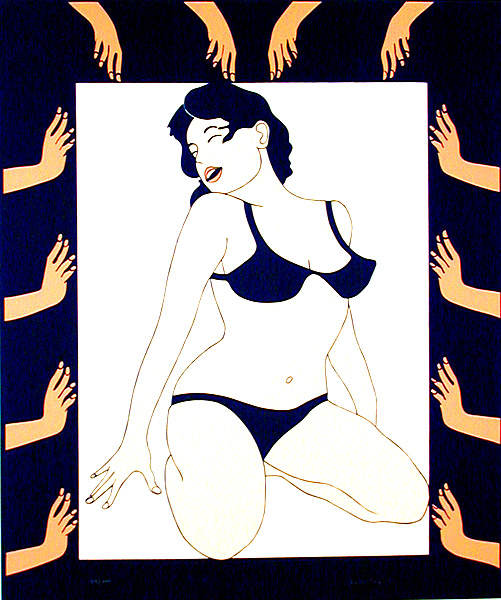|
Although he was part of the original group of POP Artists and was included in the three Pop Art Print Portfolios, Wesley, a native Callifornian, has been slow to gain the recognition he deserves. In POP ART: A Continuing History, Marco Livingstone notes that Wesley used a "straightforward linear technique associated with such non-art sources as cartoons, comics and coloring books" (82-83) and used "gentle humor . . . framing devices, symmetry, and tactics of repetition as essential ingrediants in the production of paintings that appear to be innocent in an obviously childlike way but are in fact meditative in atmosphere and sophisticated in their formal construction" (208). Meditative they may be, but if innocence is present it is often that of those who ought to know better. As a press release foor the January-February 2001 exhibition of his work at the Harvard University Art Museums points out, "Wesley has been painting acutely sexual, intensely observed, narrative paintings for more than 40 years. The conspicuous characteristics of his work since the early seventies—its insistent flatness, powdered pastel palette, cartoon/cinematographic narratives, embrace of the sexually charged encounter, sophisticated anthropomorphism, and mannered drawing—have enormous appeal for younger painters inspired by a digital revolution to rethink the medium: Wesley's painting looks like nothing else out there.
A recent retrospective at the Museum of Modern Art's P.S.1, Wesley's first in the United States, reflects this new interest in a painter who first came into prominence in the early sixties. Staged against the backdrop of the more extensive MoMA/P.S.1 retrospective, John Wesley: Love's Lust is selective rather than comprehensive, featuring work from the sixties through to the present in an effort to look more closely at Wesley's allegorical subject matter and sophisticated formal innovations. 'Wesley's compelling approach to painting encourages the viewer to question the reasons for his eccentric creations and in doing so forces us all to ponder his intended message,' said James Cuno, the Elizabeth and John Moors Cabot Director of the Harvard University Art Museums. 'Wesley has never lacked for attention,' said Linda Norden, the curator at the Fogg who organized the show. 'But critics have been eager to characterize rather than analyze the art for fear that looking too closely would kill off whatever it is that works. This exhibition is meant to show that exactly the opposite is true. Wesley's paintings can be frighteningly funny, poignant, and just plain weird; but there is a complex pictorial intelligence driving this body of work.' "
The Harvard show "includes a wide selection of acrylic-on-paper paintings, which Wesley usually enlarges on canvas. Two wall cases contain some of the traced drawings he uses to compose his paintings. Surprisingly, these tracings reveal how little is fixed by an apparently mechanical means of reproduction: Instead, what becomes quickly apparent is Wesley's mastery of subtle shifts in scale and placement. Over the last ten years, Wesley has taken another turn in his paintings, opening spaces between figures, substituting distance for repetition, and conveying character less through facial expression than by developing a complex mannered line. This seems to be John Wesley's moment: John Wesley: Love's Lust offers an overdue opportunity to examine the work of an artist who has long been loved, but never taken quite seriously enough."
The Curator of John Wesley: Paintings 1961-2000, a retrospective held during the autmn of 2000 at P.S. 1, a branch of The Museum of Modern Art, has a slightly different perspective. Alanna Heiss, P.S.1 Director, says"Wesley’s work stands eerily apart. He mixes images of traditional emblems, historical figures, comic book personalities, animals, sexy women, athletes and showgirls into surreal daydreams, prompting the viewer to rejoin her own private dream-world." This exhibition includes works ranging from his earliest paintings (Stamp, 1961) to his most recent–Showboat, 2000. To accompany this retrospective, P.S.1 has produced a catalogue including new essays by Brian O’Doherty and Carolyn Christov-Bakargiev, an interview with the artist by Alanna Heiss, a chronology by Hannah Green, and an anthology of other significant texts and color plates. Wesley is known for his consistency of palette (baby blues, cotton-candy pinks), his use of painted "frames" within his pictures, his early emblem paintings, his cartoon Bumstead paintings, and ultimately for his representations of an inner erotic voyage where we are both the voyager and the voyeur.
After moving from his native Los Angeles to New York in 1960, John Wesley began showing his work at the Robert Elkon Gallery in 1963. Donald Judd became an early supporter of Welsey’s work at that time. In a review of that first New York show he wrote "...the forms selected and shapes to which they are unobtrusively altered, the order used, and the small details are humorous and goofy." Initially considered in alignment with pop artists of the early 60s, Wesley consistently produced works of such a subtle and subversive nature as to put him in a category of his own. He used the early tools of advertising production (tracing paper and stock photographs). Influences on his work range from Surrealism to Art Nouveau, from ancient Greek pottery to Matisse. Wesley’s colorful and figurative style also reflects the "flat" world of comics and posters. His secret life is ours; the works uncover the private world of a dreamer, where the dreamer is the protagonist, the artist, and the viewer. They are icons proclaiming the sanctity of our subconscious wanderings.
Selected Bibliography: In addition to discussions of Wesley in such standard works on the POP Art Movement as Judith Goldman, The Pop Image: Prints & Multiples (NY: Marlboroush Graphics, 1994), Marco Livingstone, POP ART: A Continuing History (NY: Abrams, 1990), see R. H. Fuchs, Kasper Konig, et al, John Wesley : Paintings 1963–1992, Gouaches 1961–1992 (Frankfurt: Oktagon Verlag, 1993—Catalogue of a travelling retrospective held in Frankfurt, Amsterdam, Ludwigsburg, and Berlin between July & Oct. 1993); Alanna Heiss, John Wesley: Paintings 1961-2000 (NY: P. S. 1–MoMA, 2000).
|
|
|
